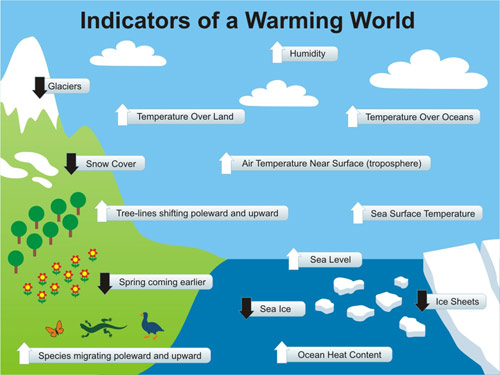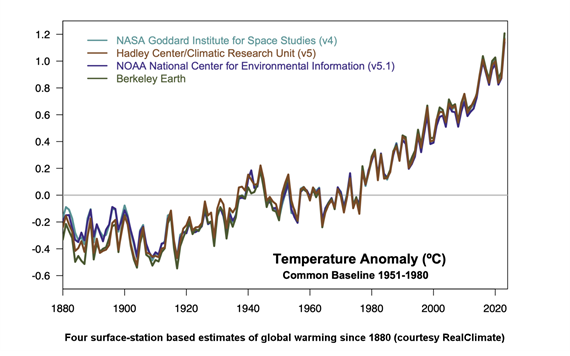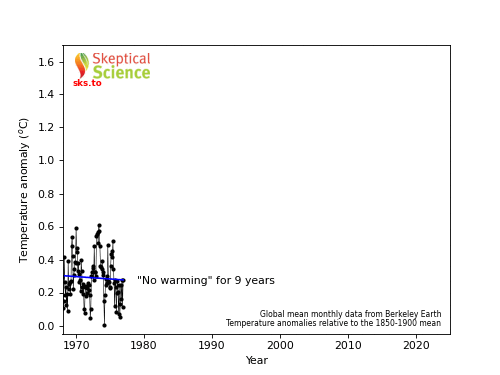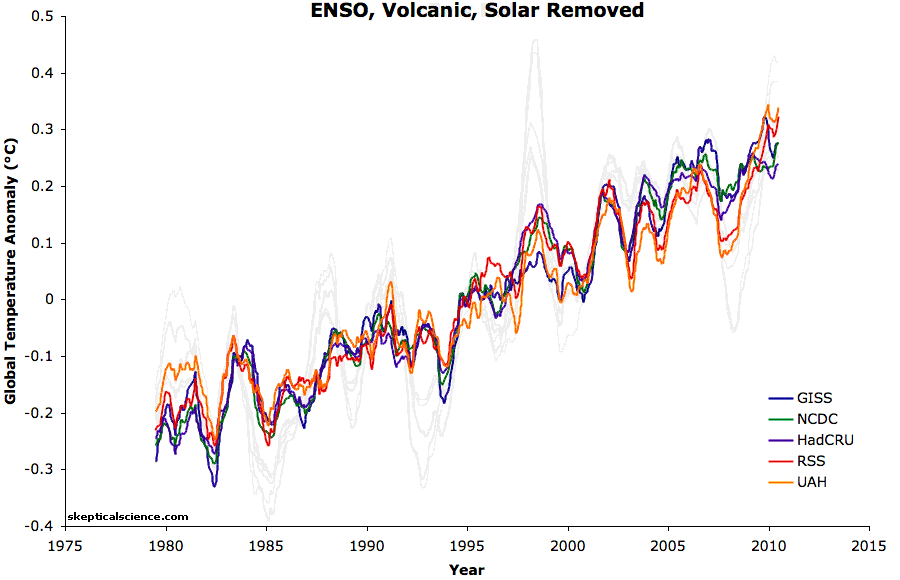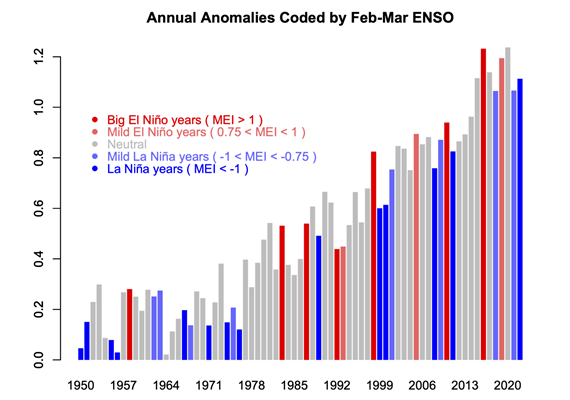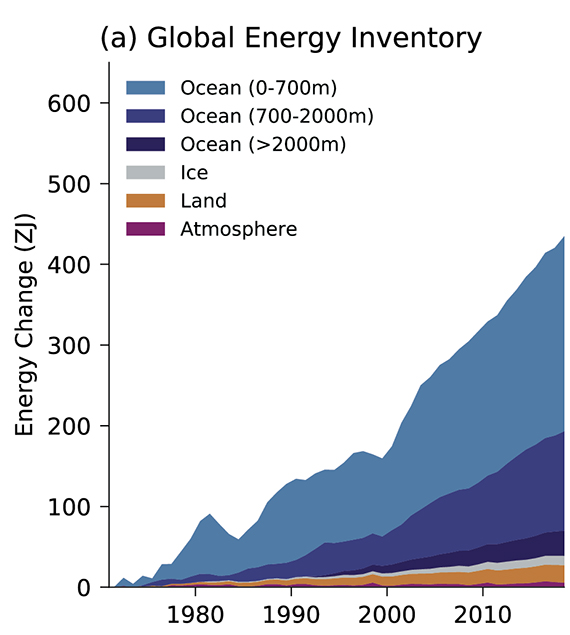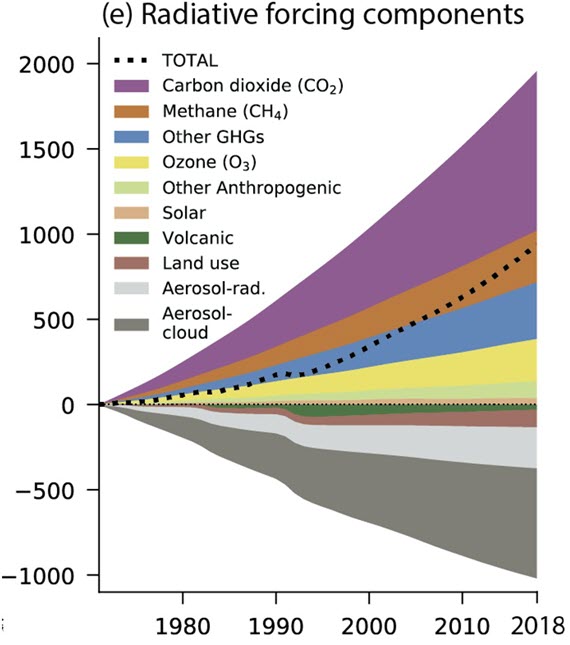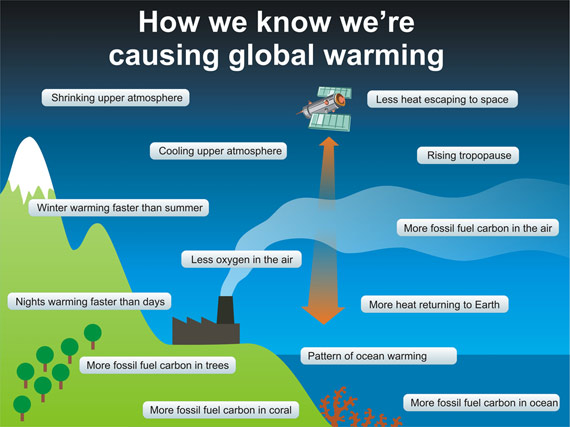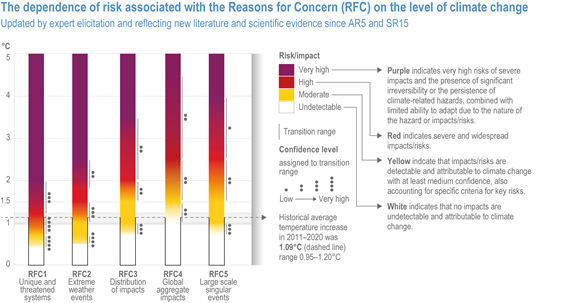The Big Picture
It's easy to get bogged down discussing one of the many pieces of evidence behind human-caused global warming, to the extent that we can't see the forest for the trees. Here, we take a step back and see how all of those trees comprise the forest as a whole. Skeptical Science provides extensive resources that examine each individual piece of climate misinformation and rebuts them with hard evidence, so let's make use of these individual pieces to see how they form the big picture.
The Earth is Warming
We know the planet is warming from surface temperature stations and satellites measuring the temperature of the Earth's surface and lower atmosphere. We also have various tools which have measured the warming of the Earth's oceans. Satellites have measured an energy imbalance at the top of the Earth's atmosphere. Glaciers, sea ice, and ice sheets are all receding. Sea levels are rising. Spring is arriving sooner each year. There's simply no doubt - the planet is warming. Everything to do with temperatures is going up. Everything to do with snow and ice is decreasing. Species are migrating polewards and to higher altitudes (Figure 1).
Figure 1: Indicators of a warming world (click for larger image)
Global Warming Continues
And yes, the warming is continuing. The 2010s were warmer than the 2000s, which were hotter than the 1990s, which were hotter than the 1980s, which were hotter than the 1970s. 2023 was the hottest year on record (Figure 2). Temperature datasets are in excellent agreement on this matter. Sea levels are still rising, ice is still receding, spring is still coming earlier and that planetary energy imbalance continues apace.
Figure 2: Four surface-station based estimates of global warming since 1880 (courtesy RealClimate)
Contrary to what the Merchants of Doubt would like us to believe, and they have tried this one more than once, the planet has not magically stopped warming. Those who argue otherwise are confusing short-term noise with long-term global warming (Figure 3).
Figure 3: This version of the Escalator graphic is based on data including the year 2022. The previous versions are still available here with data including 2015 or as a video including 2016. When Robert Rohde updated the escalator and produced a staircase of denial in January 2023, it motivated us to follow suit and to update our escalator with the latest available data as well. (click for a larger version)
El Niño-Southern Oscillation (ENSO)
Foster and Rahmstorf (2011) showed that when we filter out the short-term effects of the sun, volcanoes, and El Niño cycles, the underlying man-made global warming trend becomes even more clear (Figure 4).
Figure 4: Temperature data (with a 12-month running average) before and after the short-term factor removal, from Foster & Rahmstorf (2011).
Although such influences are sources of climate variability, the following plot of ENSO shows that El Nino (warm) and La Nina (cool) years, plus ENSO-neutral years (Figure 5), are all steadily getting warmer: they are simply noise on an upwards trend:
Figure 5: GISTEMP anomalies (with regard to the late 19th Century, colour-coded according to the status of ENSO in the early spring. Reds are El Nino years, blues La Nina and greys neutral. (courtesy RealClimate)
Global energy inventory
For as much as atmospheric temperatures are rising, the amount of energy being absorbed by the planet is even more striking when one looks into the deep oceans and the change in the global heat content (Figure 6).
Figure 6: Global energy inventory, 1971-2018, showing the breakdown of components, as indicated in the legend. Graphic from IPCC AR6 Working Group 1, Cross-Chapter Box 9.1 fig.1.
Over 90% of global warming goes into heating the oceans. When taking the heating of the entire climate system into account, the planet has warmed at a rate equivalent to 4 Hiroshima atomic bomb detonations per second over the past 15 years (Figure 7).
Figure 7 - Heat Widget from 4Hiroshimas
Humans are Increasing Atmospheric Greenhouse Gases
The amount of greenhouse gases in the atmosphere - particularly carbon dioxide (CO2) - has been rising steadily over the past 150 years. There are a number of lines of evidence which clearly demonstrate that this increase is due to human activities, primarily burning fossil fuels.
The most direct of evidence involves simple accounting. Humans are currently emitting approximately 44 billion tons of CO2 per year. That CO2 doesn't simply vanish. Half of it stays in the atmosphere, while the other half is absorbed by the oceans (which is causing another major problem - ocean acidification).
We also know the atmospheric increase is from burning fossil fuels because of the isotopic signature of the carbon in the atmosphere. Carbon comes in three different isotopes, and plants have a preference for the lightest one, carbon 12. Anything that eats plants, or eats things that eat plants, inherits that light carbon signature. So do the colossal tonnages of geological deposits made from ancient life - in other words the fossil fuels. So if the fraction of carbon 12 in the atmosphere is increasing, which it is, we know the increase is due to burning fossil fuels.
The fact that humans are responsible for the increase in atmospheric CO2 is settled science. The evidence is clear-cut.
Human Greenhouse Gases are Causing Global Warming
There is overwhelming evidence that humans are the dominant cause of the recent global warming, mainly due to our greenhouse gas emissions. Based on fundamental physics and math, we can quantify the amount of warming human activity is causing, and verify that we're responsible for essentially all of the global warming over the past 3 decades. The aforementioned Foster and Rahmstorf (2011) found a 0.16°C per decade warming trend since 1979 after filtering out the short-term noise.
In fact we expect human greenhouse gas emissions to cause more warming than we've thus far seen, due to the thermal inertia of the oceans (the time it takes to heat them). Human aerosol emissions are also offsetting a significant amount of the warming by causing global dimming. Huber and Knutti (2011) found that human greenhouse gas emissions have caused 66% more global warming than has been observed since the 1950s, because the cooling effect of human aerosol emissions have offset about 44% of that warming. Figure 8 shows a more recent assessment (from IPCC AR6) of the components of the overall temperature forcing.
Figure 8: Contributions of individual forcing agents to the total change in the decadal average temperature for the period 1971-2018. Graphic from IPCC AR6 Working Group 1, Box 7.2 fig.1 panel (e). LH scale is energy change in ZJ. Click image to see the full graphic.
Fingerprints in the climate system
There are also numerous 'fingerprints' which we would expect to see from an increased greenhouse effect (i.e. more warming at night, at higher latitudes, upper atmosphere cooling) that we have indeed observed (Figure 9).
Figure 9: Observed 'fingperprints' of man-made global warming (described here and here).
Climate models have projected the ensuing global warming to a high level of accuracy, verifying that we have a good understanding of the fundamental physics behind climate change.
Sometimes people ask "what would it take to falsify the man-made global warming theory?". Well, basically it would require that our fundamental understanding of physics be wrong, because that's what the theory is based on. This fundamental physics has been scrutinized through scientific experiments for decades to centuries.
The Warming will Continue
We also know that if we continue to emit large amounts of greenhouse gases, the planet will continue to warm. We know that the climate sensitivity to a doubling of atmospheric CO2 from the pre-industrial level of 280 parts per million by volume (ppmv) to 560 ppmv (at the beginning of 2023 we are at 420 ppmv) will cause 2–4.5°C of warming. And we're headed for 560 ppmv in the mid-to-late 21st century if we continue business-as-usual emissions.
The precise sensitivity of the climate to increasing CO2 is still fairly uncertain: 2–4.5°C is a rather wide range of likely values. However, even if we're lucky and the climate sensitivity is just 2°C for doubled atmospheric CO2, if we continue on our current emissions path, we will commit ourselves to that amount of warming (2°C above pre-industrial levels) within the next 75 years.
The Net Result will be Bad
There will be some positive results of this continued warming. For example, an open Northwest Passage, enhanced growth for some plants and improved agriculture at high latitudes (though this will require use of more fertilizers), etc. However, the negatives will almost certainly outweigh the positives, by a long shot. We're talking decreased biodiversity, water shortages, increasing heat waves (both in frequency and intensity), decreased crop yields due to these impacts, damage to infrastructure, displacement of millions of people, etc. (Figure 10).
Figure 10: Simplified presentation of the five Reasons for Concern burning ember diagrams as assessed in IPCC AR6 Working Group 2 Chapter 16 (adapted from Figure 16.15, Figure FAQ 16.5.1).
Arguments to the contrary are superficial
If there's one theme we've found in studying politically-motivated criticisms of climate science, it's that they're consistently superficial. For example, the criticisms of James Hansen's 1988 global warming projections never go beyond "he was wrong," when in reality it's important to evaluate and learn from such projections and their outcome i.e.what actually happens. Then again, those who argue that "it's the Sun" ignore the fact that we understand the major mechanisms by which the Sun influences the global climate: furthermore we study and monitor them on a continual basis. We know it's not the Sun because the data say so. Finally, those who argue "it's just a natural cycle" can never seem to identify exactly which natural cycle can explain the current warming, nor can they explain how our understanding of the fundamental climate physics is wrong.
There are legitimate unresolved questions
Much ado is made out of the expression "the science is settled." The science is settled in terms of knowing that the planet is warming rapidly, and that humans are the dominant cause.
There are certainly unresolved issues. As noted above, there's a big difference between a 2°C and a 4.5°C warming for a doubling of atmospheric CO2, and it's an important question to resolve, because we need to know how fast the planet will warm in order to know how fast we need to reduce our greenhouse gas emissions. There are significant uncertainties in some feedbacks which play into this question. For example, will clouds act as a net positive feedback (by trapping more heat, causing more warming) or negative feedback (by reflecting more sunlight, causing a cooling effect) as the planet continues to warm? And exactly how much global warming is being offset by human aerosol emissions?
These are the sorts of questions we should be debating, and the issues that many climate scientists are investigating. Unfortunately there is a very vocal contingent of people determined to continue arguing the resolved questions for which the science has already been settled. And when climate scientists are forced to respond to the constant propagation of misinformation on these settled issues, it just detracts from our investigation of the legitimate, unresolved, important questions.
Smart Risk Management Means Taking Action
People are usually very conservative when it comes to risk management. Some of us buy fire insurance for our homes when the risk of a house fire is less than 1%, for example. When it comes to important objects like cars and homes, we would rather be safe than sorry.
But there is arguably no more important object than the global climate. We rely on the climate for our basic requirements, like having enough accessible food and water. Prudent risk management in this case is clear. The scientific evidence discussed above shows indisputably that there is a risk that we are headed towards very harmful climate change. There are uncertainties as to how harmful the consequences will be, but uncertainty is not a valid reason for inaction. There's very high uncertainty whether I'll ever be in a car accident, but it would be foolish of me not to prepare for that possibility by purchasing auto insurance. Moreover, uncertainty cuts both ways, and it's just as likely that the consequences will be worse than we expect as it is that the consequences won't be very bad.
We Can Solve the Problem
The good news is that we have the tools we need to mitigate the risk posed by climate change. A number of plans have been put forth to achieve the necessary greenhouse gas emissions cuts (i.e. here and here and here). We already have all the technology we need.
Opponents often argue that mitigating global warming will hurt the economy, but the opposite is true. Those who argue that reducing emissions will be too expensive ignore the costs of climate change - economic studies have consistently shown that mitigation is several times less costly than trying to adapt to climate change (Figure 11).
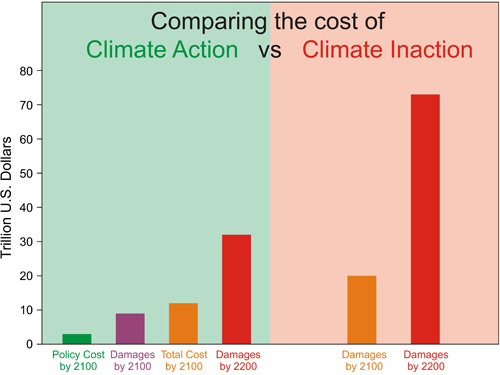
Figure 11: Approximate costs of climate action (green) and inaction (red) in 2100 and 2200. Sources: German Institute for Economic Research and Watkiss et al. 2005
This is why there is a consensus among economists with expertise in climate that we should put a price on carbon emissions (Figure 12).
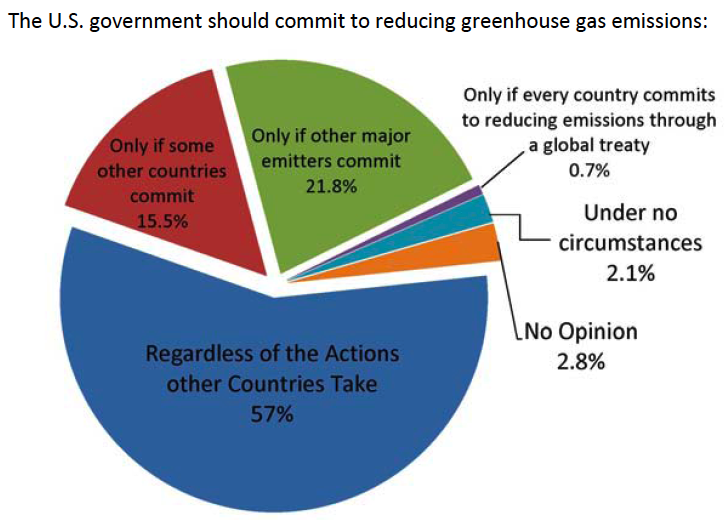
Figure 12: New York University survey results of economists with climate expertise when asked under what circumstances the USA should reduce its emissions (Policy Brief: Economists and Climate Change. Consensus and Open Questions, Holladay et al. 2009)
The Big Picture
The big picture is that we know the planet is warming, humans are causing it, there is a substantial risk to continuing on our current path, but we don't know exactly how large the risk is. However, uncertainty regarding the magnitude of the risk is not an excuse to ignore it. We also know that if we continue on a business-as-usual path, the risk of catastrophic consequences is very high. In fact, the larger the uncertainty, the greater the potential for the exceptionally high risk scenario to become reality. We need to continue to decrease the uncertainty, but it's also critical to acknowledge what we know and what questions have been resolved, and that taking no action is not an option. Th good news is that we know how to solve the problem, and that doing so will minimize the impact not only on the climate, but also on the economy.
The bottom line is that from every perspective - scientific, risk management, economic, etc. - there is no reason not to immeditately take serious action to mitigate climate change. Failing to do so would be exceptionally foolish. Or, as the late Nobel Prize-winning scientist Sherwood Rowland (1927-2012), who made the 1970s discovery that chlorofluorocarbons (CFCs) in our atmosphere cause major damage to Earth's ozone layer, put it many years ago:
"What's the use of having developed a science well enough to make predictions if, in the end, all we're willing to do is stand around and wait for them to come true?"
Updated on February 12, 2024 with Figure 2 now including the year 2023.































 Arguments
Arguments






















